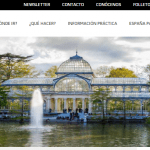SEGITTUR has presented its Guide for Best Practices in Sustainability for Smart Destinations, the objective of which is to serve as a reference for destination managers, organisations and tourism professionals to find out more about success stories and progress towards tourism sustainability.
The Guide, prepared in the context of the Smart Tourism Network, analyses seven challenges for destinations to address sustainability: governance, climate change and the decarbonisation of tourism; knowledge and monitoring of tourist activity; and communication and training in sustainability.
This is in addition to financing and management of economic resources for tourism sustainability; the redefinition of the concept of tourism success and growth; and human rights, labour rights and gender equality in tourism.
Following the Covid-19 crisis, destinations have increased their commitment to a more sustainable tourism model. However, as part of this process, they come across challenges that threaten their commitment to protect the natural environment and cultural heritage, and promote the socio-economic development of the local community. With this in mind, the guide aims to help as much as possible by setting out a list of best practices in the matter.
The guide consists of 27 global good practices that contribute to making progress with sustainability objectives; to guarantee the quality of tourist attractions; to minimise the impacts caused by the development of tourism; to strengthen relations between the different stakeholders involved in tourist activities; as well as to implement continuous improvement processes.
The best practices included in the guide encompass four aspects of sustainability: management of conservation tourism sustainability; improvement and recovery of cultural heritage; conservation and improvement of the environment; and sustainable development and circular economy.
International best practices include the case of Bhutan, which has implemented a programme to combat rural depopulation and distribute the benefits of tourism. Also worth note is the commitment of Curitiba in Brazil to promotion the destination through artisan products.
In the case of Spain, worth particular mention is the case of the island of Tenerife and its commitment to low-impact accommodation and high energy efficiency; as well as the Green Belt in Vitoria, which has made a commitment to sustainability-based urban development. Other projects include the Murcia project forming networks, sustainable food and support for zero-kilometre agricultural products that seeks sustainable development using local resources.
Australia, Azores, Benidorm, Chiclana, Costa Rica, Donostia San Sebastian, Dubrovnik (Croatia), Galapagos (Ecuador), Gijón, Málaga, Mallorca, Puerto de la Cruz, Ribera de Navarra, Rotterdam, Santander, Sydney, Sweden, Thailand, The Bay of Plenty, Torremolinos and Valencia are the other destinations whose best practices have been chosen.
This Guide on Best Practices combines a series of manuals, guides and guidelines published by the Smart Destination Network, which contribute to providing guidelines, tools and instruments to promote the recovery of destinations and generation of knowledge in tourism





